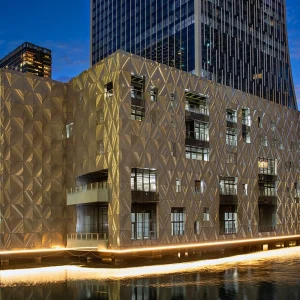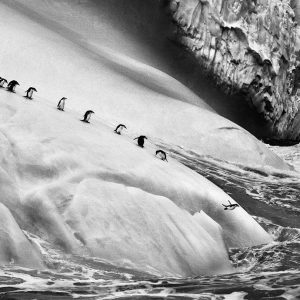
MediaCom, by Sheila Bird Group
Created as a base for media buying agency MediaCom, the vivid interior design of this refurbished old mill in Leeds utilises a combination of striking flooring choices to bring this creative design to life.
Set in an up-and-coming corner of the city, the mill has undergone extensive regeneration to create a hub for a collection of media businesses. For MediaCom, the brief was simple: create a lively and inspiring place to work, with the design conveying the personality and values of the business.
Atul Bansal, design partner and founder of Sheila Bird Group, was commissioned to design the scheme. He specified 350 sq m of Forbo Tessera Circulate in the colourway Turbine – a mixture of black and grey – as the main component of the flooring design. It was installed in the main working and circulation areas of the open-plan offices.
Boldly contrasting sharp geometric lines with organic curves, Tessera Circulate is a random lay batchless carpet tile that is practical for all sizes of commercial installations. Comprising tonal blocks of colour intersected by concentric circles, it creates an unusual aesthetic as the circles randomly connect across the floor.
Contrasting this, Bansal specified 100 sq m of Westbond Colour tiles, in Douglas Pink, Graphite and Prune, for the conference rooms and breakout spaces.
Westbond carpet tiles are premium quality fusion-bonded tiles in which the yarn is fixed directly on to the backing material, resulting in a dense and luxurious product.
Colour and pattern played a major role in the MediaCom interior design, says Bansal: ‘It was really important that we brought the space to life, and the carpet tiles were the anchor around which we based the colours and textures of the rest of the scheme. MediaCom has a vibrant brand personality so it was essential that this was translated into the design – and like all personalities, we wanted to convey that it has multiple layers.
‘Tessera Circulate instantly grabbed me with its contemporary aesthetic, and in this design it reflects the vibrant, fast-paced and youthful side of the business. Similarly, the Westbond Colour tile in Graphite represents the mature side of the brand and its long history, while the vivid pink tile reflects the company’s humour and echoes the tones used in its literature and online presence."
Contrasts in colour and pattern create visual markers throughout the interior to highlight activity zones such as workstations, meeting areas and chill-out spaces. As modular floor coverings, the carpet tiles lend themselves to this sort of application, as well as mixing easily with other materials. For example, Bansal also specified 15 sq m of Forbo’s Eternal Contrast in Mercury for the kitchen areas to provide a finish that could copy easily with any spills or splashes.
Simon Price, director of MediaCom, commented: ‘We are very pleased with our new offices. The flooring’s colours and patterns are a great reflection of MediaCom’s brand values and have really helped transform the space.’
Noma, by Space Architecture and Design
The redesign of the restaurant Noma in Copenhagen was undertaken by Signe Bindslev Henriksen and Peter Bundgaard Rützou of Space Architecture and Design, with a tight timescale presenting a major challenge in this large space.
‘Luckily we knew the space and existing conditions of Noma very well, which helped us a lot since we only had limited time to do both the sketching and planning of the total project,’ says Henriksen. ‘Execution time was also very tight, with a total of three weeks to complete the redesign. In addition, Noma is in a listed building with a lot of restrictions. So as not to lose time, alongside sketching and investigating ideas in 3D we simultaneously worked with developing physical samples, materials, surfaces, furniture prototyping – almost as a 1:1 mood board.’
The Space team worked closely with the restaurant on ideas and suggestions on how to express the values of the brand as honestly and accurately as possible. ‘We started out imagining a completely new take on the space – both in terms of flow and style – but ended up finding that it seemed both too pretentious and forced conceptually,’ Henriksen explains. ‘So instead we delved into the analyses of possibilities together with the Noma team and investigated where we could improve both the functional and spatial experience as well as ambience.’
It became very much a question of finding new ways of treating and using organic materials and changing colour palettes, making a virtue of reusing some of the existing features and combining them with new elements, such as new hardwood flooring, lounge flow and furniture.
For René Redzepi, chef and co-owner of Noma, the new flooring – by Danish manufacturer Dinesen – has helped reinvent the overall ambience of the space. He says: ‘The floorboards have done wonders for our restaurant. It is beautiful, fits Noma’s style and values perfectly and, as a bonus, has improved the acoustics considerably, which is important to us.
‘All the waiting staff are thrilled about the thick oak boards. They feel great when you walk on them and at the same time they contribute in creating a pleasant atmosphere in the restaurant.’
Mittelman Associates
Kährs Oak Maggiore wood floor was specified by Mittelman Associates, for its own offices in an office complex in south London. Part of Kährs new Da Dapo Collection, the one-strip floor has a distinct authentically aged finish, chosen to bring a warm, rustic feel to the spacious interior.
The ground floor installation totalled 130 sq m, incorporating a cafe and break-out/meeting zone, with all flooring installed by Evergreen Building.
With its features including cracks, knots, gnarls and pegs, the Da Capo Collection combines an antiqued look with the performance benefits of a modern construction. The range includes six designs crafted from sustainable oak, with each floor brushed, handscraped, bevelled and smoked to achieve a vintage look.
Fira 2 metro station, Barcelona by Toyo Ito & Associates
The Fira 2 metro station, at one end of the Fira de Barcelona trade fair complex, is intended to serve a dual purpose – not only as an entrance to the exhibition centre but also as a museum of the Fira Barcelona. It boasts tiled walls featuring screen-printed images that serve as a photographic archive from 1890 to 2009, providing information on the history of Fira Barcelona and its connections with the city over the years.
Due to it being a high foot-traffic area and because of the vibrations caused by the metro, Toyo Ito & Associates decided to use porcelain stoneware tiles, for their durability, resistance to vandalism and easy maintenance. The tiles had to be in specific blue colours to tie in with the overall colour schemes used throughout the exhibition centre.
The tiles – supplied by Porcelanosa – were also given a ‘peppered’ effect to make them even more hardwearing. Paving tiles were pre-cut with water jet and organised and coded in groups so that they could be positioned according to the laying ‘map’. By using ceramic tiles, it was also possible to run water down steps, creating an eye-catching feature.
Toyo Ito & Associates says: ‘For the screen printing on the tiles, we looked for photographs in the historic archive of l’Hospitalet [the local district authority] and the private collections of a number of photographers, including Company and Àngel Toldrà Viazzo.
‘Modern photographs were also added, as the station should last for a minimum of 30 years. We involved the different people who held the rights to the images; they collaborated with us and in the end transferred the rights to us for free.’
After choosing the photographs, the images were restored, given a colour treatment to produce the special twin-blue tone, and then a halftone filter to give them a uniform appearance in large format.
They were then cut into shapes reminiscent of the Fira’s ‘organic wall’, giving the sensation of being droplets from moments in local history frozen in time. Finally, information captions were discretely added to the images.





